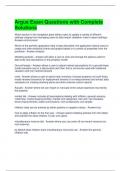Exam (elaborations)
Argus Exam Questions with Complete Solutions
- Course
- Institution
Argus Exam Questions with Complete Solutions Which section in the navigation pane allows users to update a variety of different settings ranging from managing users to data import validation rules to report settings - Answer-control panel Which of the portfolio application tabs is best describe...
[Show more]



